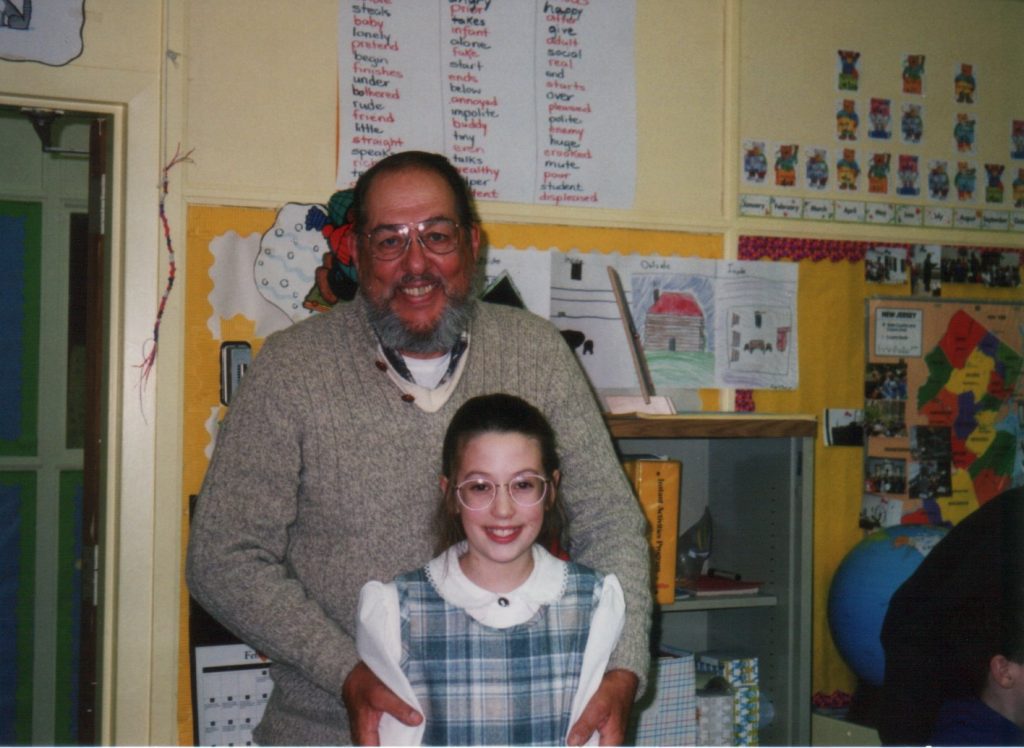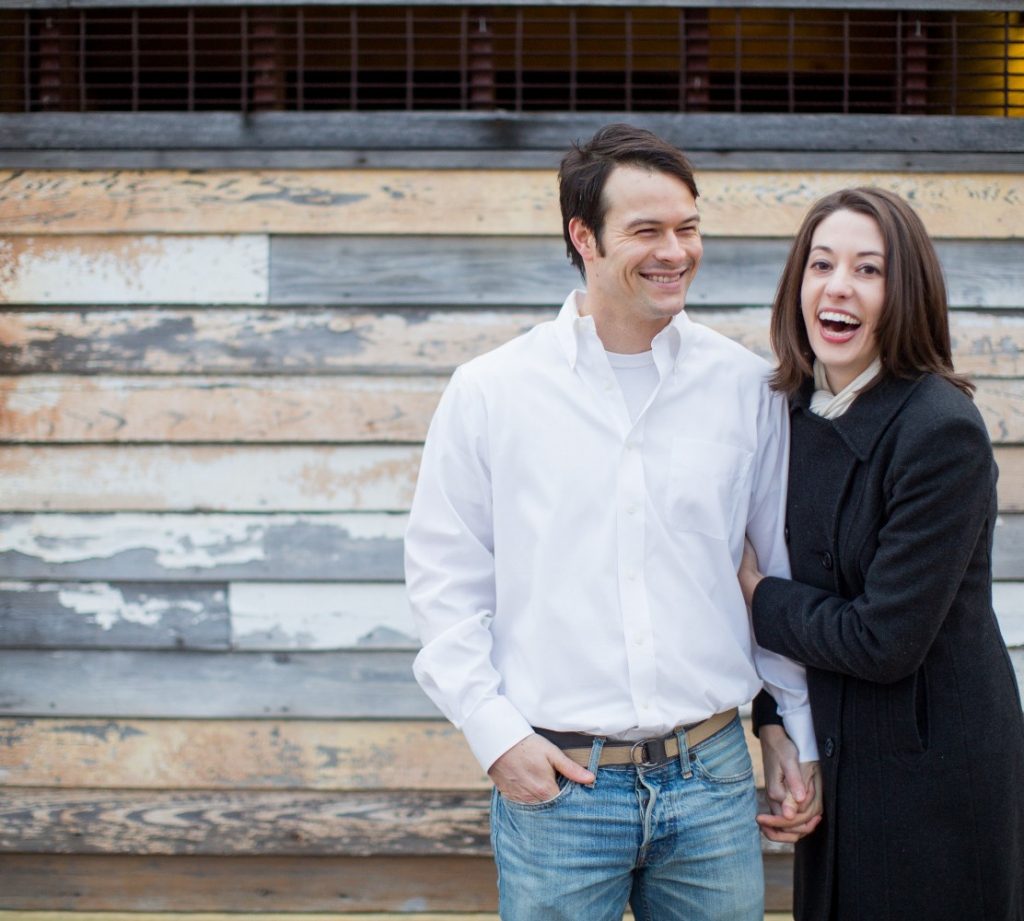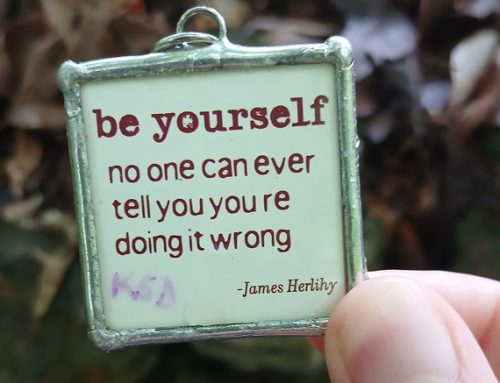Before I had kids, I read about a mom who “organized her time so ruthlessly that she always keyed in 1:11 or 2:22 or 3:33 on the microwave … because hitting the same number 3 times took less time.” (Brigid Schulte, Overwhelmed.)
It scared me to think that I might become her. And then one day I looked up and realized that I already had. I was time strapped and frazzled. And also, my house was a total mess. But how to start decluttering when overwhelmed?
How the heck was I meant to make time to sort and subtract, when I was so busy caring for others?
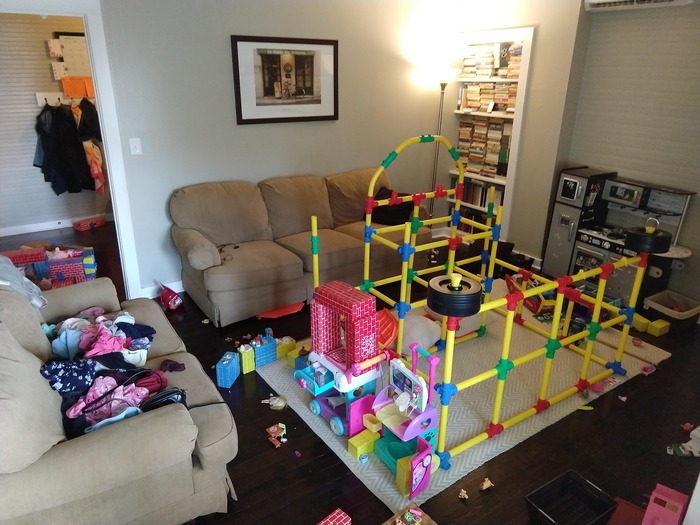
Our living room, fall 2024, with kids ages 3 and 5. Obviously, this is a pre-declutter picture.
If you’re struggling to shift your mindset to focus more time and energy on yourself, then this post is for you. It’s my intention to help you get free of the mountain of clutter, and even to enjoy the process of subtraction itself.
That might sound like a stretch for now, but did you know that happiness research indicates that removing something negative in our lives has a greater overall impact on our well-being than including something positive?
It’s true! In other words: If you can figure out how to deal with your clutter and get rid of stuff that’s weighing you down, you will be happier than if you added in, say, a massage or a pedicure.
I love this research finding, because it implies that in the equation of a happy life, subtraction is more important than addition. Or put another way, “Less negative beats more positive.”
That’s why I take a different approach to most coaches. I’m not here to help you optimize your time, or help you create a complex calendar or task list. Most of the time, what’s needed is not to add a new organizing system, but rather, to subtract the excess.
When you have just a few books to store, you don’t need to spend time and money on the perfect bookcase. When you have a small wardrobe, you don’t need to move to a house with bigger closets. We’ve been sold on the allure of more stuff, but in my experience, having less is one key to freedom.
You might be wondering: What does this have to do with recovering from perfectionism? Or with living like you don’t owe anyone? Or with freeing up time to pursue your purpose? Well, having coached hundreds of people over the years, I can see a trend.
If a client is overwhelmed, her space reflects that. If a client is overextended, then her space is jammed with stuff. What saddens me is that often this huge amount of stuff stops her from living the life she wants … from traveling to pursuing a new relationship to just having more fun!
I’ve heard so many accomplished, well-educated women apologize for the state of their homes. I’ve seen so many clients choose a pretty Zoom background when we start working together virtually … and then, as we build trust, they take it down so we can both see the piles behind them.
Why is this so? Well, as I learned from my favorite coach, Dr. Martha Beck, people tend to create three-dimensional portraits of their inner lives via their living spaces. And as such, there’s a really interesting relationship between physical clutter and emotional overwhelm.
Often when you address one, the other subsides. So, if you’ve been overextending yourself, one great way to pull your energy back is to take a closer look at your living space. Remember, learning how to solve our own problems gives us a greater happiness boost than just about anything else.
My house is so cluttered, I don’t know where to start!
I’ve heard this one a hundred times! Let me outline three different approaches, so you can pick the one that suits you best.
Approach #1: Start anywhere simple.
Most organizers will tell you to just start with the easy stuff, and throw out obvious trash and recycling. There’s some wisdom in this; clearing some space lets you see progress, and may inspire you to do more. This is a good approach if a quick win helps you get momentum going.
However, you also run the risk of only doing the easier stuff, and avoiding the areas that are actually causing you the most distress. Think about it: maybe your hallway is the easiest to organize, but it’s your office that’s really stressing you out.
Which brings me to the second approach …
Approach #2: Start with the place that’s bugging you the most.
With this approach, you begin with whatever space is causing you the most stress on a regular basis. You go right to the biggest pain point, and start there. This is great for making a significant difference in a small amount of time.
That said, this approach can also backfire because it requires you to take on what may be the toughest challenge when you haven’t had sufficient practice yet. For example, what if your biggest source of office clutter is furniture you’ve held on to from a loved one who died?
This furniture represents grief you haven’t processed, and a future you haven’t allowed yourself to imagine yet. If that’s the case, you probably need to develop two skills: first, the skill of allowing yourself to grieve, and second, the skill of being rigorously honest with yourself.
In order to decide what to do with the furniture, you need to look forward, not backward. You need a clear vision of what you’d like your life to look like over the next nine months. That way, you’ll be able to look at each item and answer the key question, “Does this item serve my purpose?”
That approach is really helpful for some people. But what if you don’t relate to that example? What if it’s all just low-grade struggle; maybe your home just feels cluttered all over? In that case, let’s talk about the third approach.
Approach #3: Start with your wardrobe.
This approach comes from tidying guru Marie Kondo, creator of the KonMari method. She recommends clearing your entire home, starting with your clothes.
After thousands of hours of coaching clients, I find it interesting that when people are ready to make a big change, they often instinctively begin with their clothes. Clothes represent identity, and how we present ourselves to the world.
So if our identity is shifting — perhaps going from stay-at-home mom to businesswoman, or vice-versa — then it makes sense to start with our wardrobes.
It’s also a good idea to start here because by definition, your clothing belongs to you alone. As such, it’s less tricky than decluttering shared household items, such as kitchen tools or patio furniture. You get to make all the decisions unilaterally.
So if you hear yourself saying, “My house is so cluttered, I don’t know where to start,” remember that you have options. You can start with low-hanging fruit and build from there. You can begin with the place of least satisfaction.
Or, you can start with your wardrobe. Let me tell you the story of how a single wardrobe declutter changed my life for the better. Throughout, I’ll share principles that you can use to help declutter in any area you choose.
How to start decluttering clothes
It’s funny how, without meaning to, we can get stuck seeing ourselves a certain way. Until recently, I’d feel bemused (and even confused) whenever someone complimented me on my appearance or clothing choices.
I’d smile and say thank you, but still, a voice inside would say, Oh, if only they knew …
Sure, I might appear to be a grown woman wearing a nice dress, but inside of me lived a shy, vulnerable girl who chose to wear prairie dresses and cameos in homage to her early literary hero, Laura Ingalls Wilder. Lest you think I exaggerate, I will include photographic evidence.
As you’d expect, I got teased about my clothes a lot; even my good friends thought they were weird. I hardly ever felt like I was wearing the right thing, or that I was cool.
By contrast, my husband Jonathan remembers looking around his middle school, wondering at his peers’ collective obsession with being ‘the cool people’. Then he had this epiphany: “Wait a minute … I am the cool people!”
I wish I could have gone through life with this same assurance, but then, I’m guessing that this realization came easier for him. After all, he never wore a sunbonnet to school.
In many ways, I’ve moved past that shy-girl identity. Charlotte Bronte is my homegirl forever, yes, but I don’t need to dress like her. I’m learning to be confident in my own shoes, rather than pretending to be someone else. But in times of stress or uncertainty, I slip into old patterns.
It’s a vicious cycle: when I feel vulnerable, I don’t want to be seen, so I shy away from dressing well. But then I feel even more insecure, which makes me want to hide. And I look down at my scuffed, cracking boots and wonder what’s wrong with me.
Fortunately, I’ve worked with some incredible coaches and a great therapist who helped me get to the roots of the issue. With their help, I was able to see that my clothes reflected learned patterns of self-denial and self-abandonment.
Growing up in a controlling church that turned out to be a doomsday cult, having a younger sibling with very high support needs and severe behavioral issues, being a parentified daughter, living with undiagnosed anxiety and OCD … no wonder I’d simply given up on dressing well.
I’d thought of my inability to wear nice clothes as a character flaw, when actually, it was the result of my limiting beliefs. I grew up believing that getting rid of clothing was wasteful, and also that I shouldn’t spend any money on “frivolous” things. Instead, I should give the money to the church.
For practically my whole adult life, I’d beaten myself up for not dressing better, while simultaneously refusing to give up ratty clothes, much less buy nice ones. I’d pushed myself to obey contradictory internal commands: dress well, but don’t throw anything away or spend any money.
Finally, I broke free of the double bind. I cleaned out my closet and made a shopping list of the wardrobe basics I lacked. How did I decide? (How to start decluttering clothes?) I only kept clothes that made me feel joyful and confident.
I tossed or donated items that made me feel as poor as a beggar in a Dickens novel. There were a surprising number of unlovely freebies: the stained neon running shirt, the zebra-striped shorts. Each time I wore them, I had to tune out the inner voice that said, Ugh, I don’t like this.
How to start decluttering when overwhelmed at home
I found it most difficult to let go of worn-out items that were gifted to me. My mom gave me those yoga pants, and they’d been cute before I’d worn them every week for two years. My friend Rachel gave me that satin top, and it had made me feel glamorous before it discolored.
Often we keep things we don’t like because we’re trying to protect someone’s feelings … or, because we haven’t yet strengthened our ability to receive more than the minimum. Here’s the thing about overwhelm that no one talks about – often, it’s connected to an inability to receive.
As I was talking to Tam Orlando about her Reclaim Your Space business, she said something striking: “Clutter doesn’t say anything about your worthiness, your value, or your abilities. But often it does say something about the levels of support you are willing or able to receive.”
Ongoing overwhelm is the same way. It doesn’t say a thing about our capability or our strength. But it does say something about whether we’re willing or able to receive. So what do we do? We start by bringing awareness, by noticing what’s really going on. We ask ourselves:
- Where am I forcing a fit?
- What’s not working for me anymore?
- How can I receive support with this?
- How can I practice getting out of people-pleasing and living in integrity?
Let me take a minute here to address the emotional overwhelm that often arises during a declutter. This type of overwhelm comes when you experience strong emotion (usually fear, anger, or sadness) related to an item.
Something about it brings up strong feelings that have never been processed, old hurts that have never been healed. Your mind argues that you’re being unreasonable, just get rid of this thing already! Intellectually, you know it’s doable. But your heart is hurting; your pain demands to be felt.
In this case, the solution is to learn exactly how to apply love to the parts of yourself that hurt. Once you do that, decluttering becomes much easier. This kind of overwhelm recedes once you learn to love yourself.
There was sadness in letting these things go, but there was also a tremendous rush of energy. Facing up to the truth about my clothes made me feel great, whereas staying in denial depleted me. When I let them go, it made me feel like I could be trusted to lead my own life.
That’s the thing about decluttering your clothes: it’s a tactile truth-telling exercise. To me, cleaning my closet is not about being wasteful, spending lots of money, or becoming a fashion plate. Instead, it’s about practicing self-honesty.
When I get real about which clothes look good, I can tap into that honesty in other areas of life. It’s transitive. Admitting that a shirt’s life is over somehow empowers me to see what else in my life is over, too.
How to start decluttering when overwhelmed at work
Which brings me to another type of overwhelm that I see in the decluttering process: when you are living beyond your capacity to cope. You’re pressuring yourself to do something that is simply not reasonable at work, and that gets reflected in your living space.
For example, you might be caring for a vulnerable loved one all by yourself, or working a project with a physically impossible deadline. You might be working 3 jobs, or trying to complete 13 online courses at once, or processing 400+ incoming emails a day.
Your mind tells you to just get it done! You should be able to handle it! But deep down you know that it’s not right to demand this of yourself. In this case, the solution is to take things off your plate. This type of overwhelm recedes once you learn to free yourself from the weight of expectations.
Enter your email address below to receive the Sacred Circle Exercise and free up at least 260 hours of your precious time this year.
Free Up Time to Pursue Your Purpose with the Sacred Circle exercise!
Back to my clothing declutter: getting rid of the low-self-worth items made me start wearing the nicer stuff. Initially, I’d worried that doing so would mean I was somehow selfish and self-centered – but as it turns out, the truth is just the opposite.
Wearing clothes that fit and look good frees me to focus on other people! When I go for a walk in athletic clothes that aren’t rags, I am more likely to smile and be friendly. When I push myself to wear a fitted jacket instead of my pajama fleece, I feel better about walking into the world.
Ever since I made the resolution to dress better, I’ve felt the weight of self-consciousness lifting. But even if I don’t see anyone when I’m wearing nicer clothes, I’ve discovered that feeling good about myself is reason enough.
And when I chose to care for my physical self by dressing better, that decision rippled outward. When I tossed my shabby clothes, I discovered a decreased tolerance for shabby behavior. I stopped making excuses and started making changes.
Yes, I purchased a couple of new items, but the real power was in subtraction, in getting rid of the duds in my closet. When I started wearing the nicer clothes I already had – when I dressed for each day as though I was a person of value – something shifted. I began to value myself.
Help, I’m Overwhelmed!
Years ago, a listener wrote in to me with this question: “Help, I’m overwhelmed! If you are feeling overwhelmed, how to do you slow down to know what to focus on? Should I focus on decluttering and mediation first then let whatever happens happens or should I actively try to find my purpose?”
Listen in for my reply…
Especially pay attention to the end, when I talk about lovingly setting limits with yourself. I limit the number of email list subscriptions I receive (7 or less), the number of books I keep (2 small shelves), and the number of courses I take (1 at a time).
Where do you need to set a loving limit?
How to declutter when you want to keep everything
This is the last question I get a lot: People come to me in overwhelm – physical, mental, emotional, and spiritual overload – but they also do not want to let anything go, or take anything off their plate. Simply put, they’re afraid, and they’re in conflict.
Part of them is screaming for the relief of less, while another part of them is clinging to their stuff. Once again, in order to move forward, we need to get rigorously honest. Because the truth is, we don’t really want all of this.
Yes, our mind may tell us that we want it. We may even believe that. But if we go deeper, if we look into our hearts, we discover something very different. Let me tell you a story to show what I mean.
A couple of years ago, I asked a mentor of mine, psychologist Dr. Amy Johnson, how she built her very successful business without burnout. I thought she might talk about developing a strong work ethic, or strategic scheduling. Instead, she blew me away by saying this:
“I cannot do stuff I don’t want to do. It’s not in my DNA, I refuse. There are so many things in my business … people that I’ve paid a lot of money to have suggested I do things that I don’t like doing. And I refuse to do them.
The ultimate test is what lights me up. Once someone gets clear on what they want to do, and gets really focused on what feels super good to them, that’s often when things tend to go really well. People will get on board with that with you.”
Here’s what clicked for me when she said that. Before, I thought that the reason I wasn’t “farther along” in certain areas of my life and business was that I just wasn’t working hard enough, or doing more.
But it suddenly dawned on me that the opposite was true. The reason I was not “farther along” in those areas of my life and business was that I was willing to work too hard on too many things that did not light me up.
For me, the way out of overwhelm was about becoming radically honest. What truly lit me up? What did I love, and what was I doing because I felt like I was supposed to? When I started devoting more time and energy to what lit me up, everything shifted for the better.
Speaking of which …
Want to breathe easier?
Consider a private Breakaway Retreat with me. Breakaway Retreats are unique solo getaways, designed to support you in creating a life that welcomes you … a life that feels both freer and lighter.
You’ll stay in our cozy Wildwood Cottage Airbnb in historic downtown Florence, AL, which is a safe, private space to reconnect to yourself.
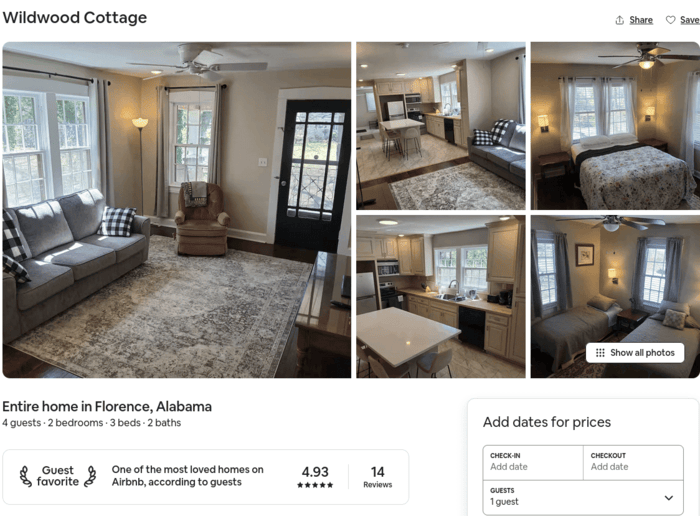
We work out retreat dates according to your availability now through the end of the year, with a max stay of four days and four nights. Interested? Click here to book a Clarity Call with me.
Share This:
Comments
Related Posts
